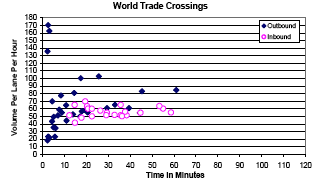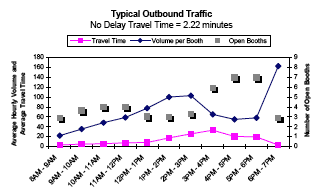World Trade Bridge Crossing Summary
The World Trade Crossing (International Bridge 4) in Laredo, Texas is the most important truck crossing on the United States/Mexican border. Texas border crossings account for most of the truck traffic and the Laredo crossing alone represents over 60% of the truck traffic crossing the border between Texas and Mexico. Table 1 shows truck traffic for 2000 crossing the border from Mexico to the United States. The World Trade bridge crosses the Rio Grande River that separates Laredo, Texas from Nuevo Laredo, Tamaulipas, Mexico and provides a link between I-35 in the United States with such Mexican cities as Monterrey and Mexico City. Most (up to 90%) of the truck traffic at the World Trade Bridge in Laredo consists of "drayage." That is, short distance shipments between warehouses in Laredo and Nuevo Laredo. Typically, long distance trucks in either Mexico or the United States unload their cargos at a warehouse where it is transferred to a short haul truck for the trip across the border. Other shipments move directly from a factory near the border in Mexico to a warehouse across the border in Texas or from a warehouse in Texas to a factory in Mexico. These short haul trucks usually make up to three trips a day across the border. Figure 1 shows a map of the general region in Texas and Mexico that provides access to the border. Figure 2 shows the location of the World Trade Bridge within the city of Laredo.
| Baseline Time[1] | Average Crossing Time[2] | 95th Percentile Time[3] | Buffer Time[4] | Buffer Index[5] | |
|---|---|---|---|---|---|
| Outbound | 1.8 | 17.2 | 45.0 | 27.8 | 161.6 |
| Inbound | 12.2 | 31.2 | 54.9 | 23.7 | 76.0 |
Notes:
- Baseline time (in minutes) to travel the study distance (between the starting point in the exporting country and the initial inspection point in the importing country) in free-flow traffic conditions.
- Average crossing time (in minutes) to travel the study distance.
- Time (in minutes) for 95 percent of trucks to travel the study distance.
- Time (in minutes) between the average time and the 95th percentile time for trucks to travel the study distance. This is the "extra time" that must be budgeted to cross the border relative to the average time.
- Buffer time necessary expressed as a percentage of average time. This is the extra percentage of average time that must be budgeted to cross the border.


